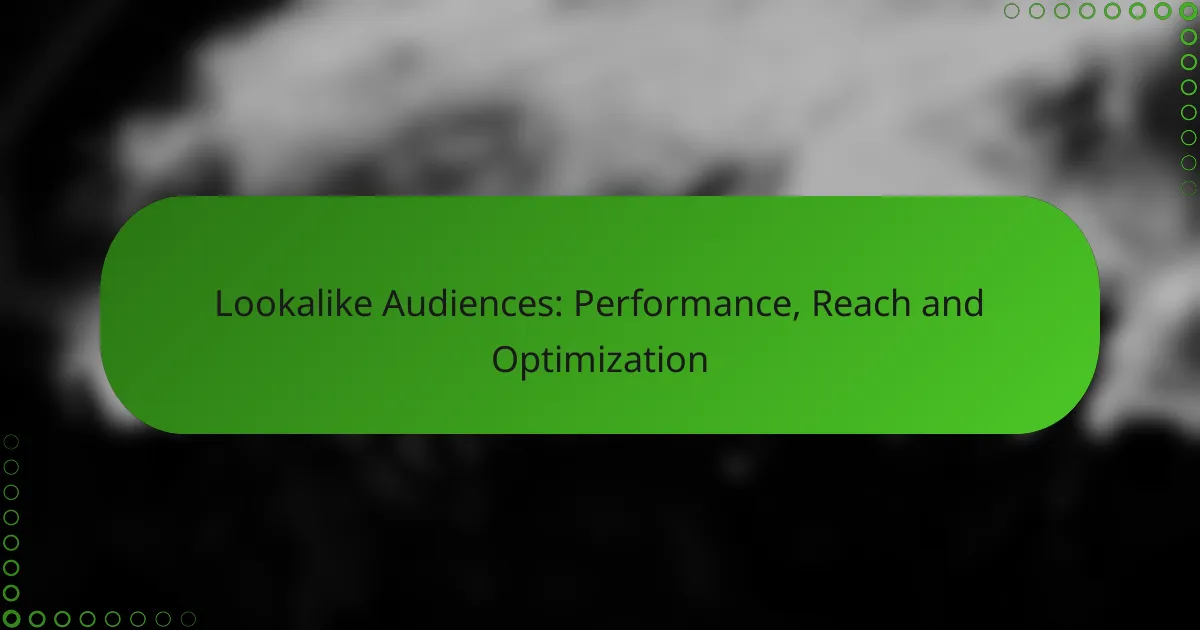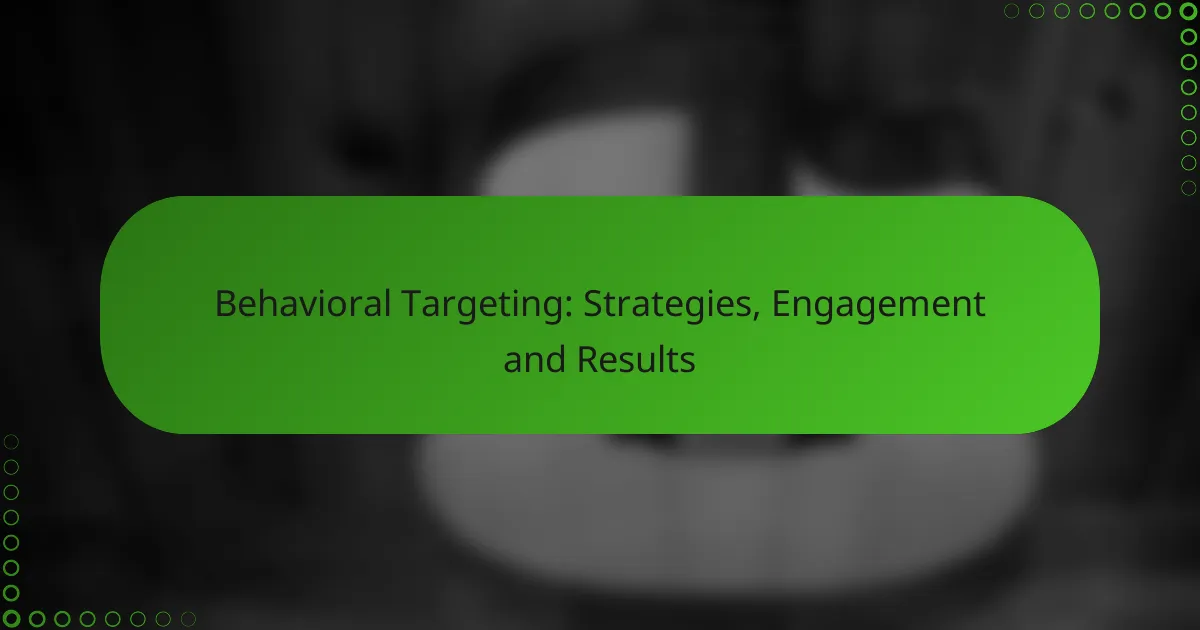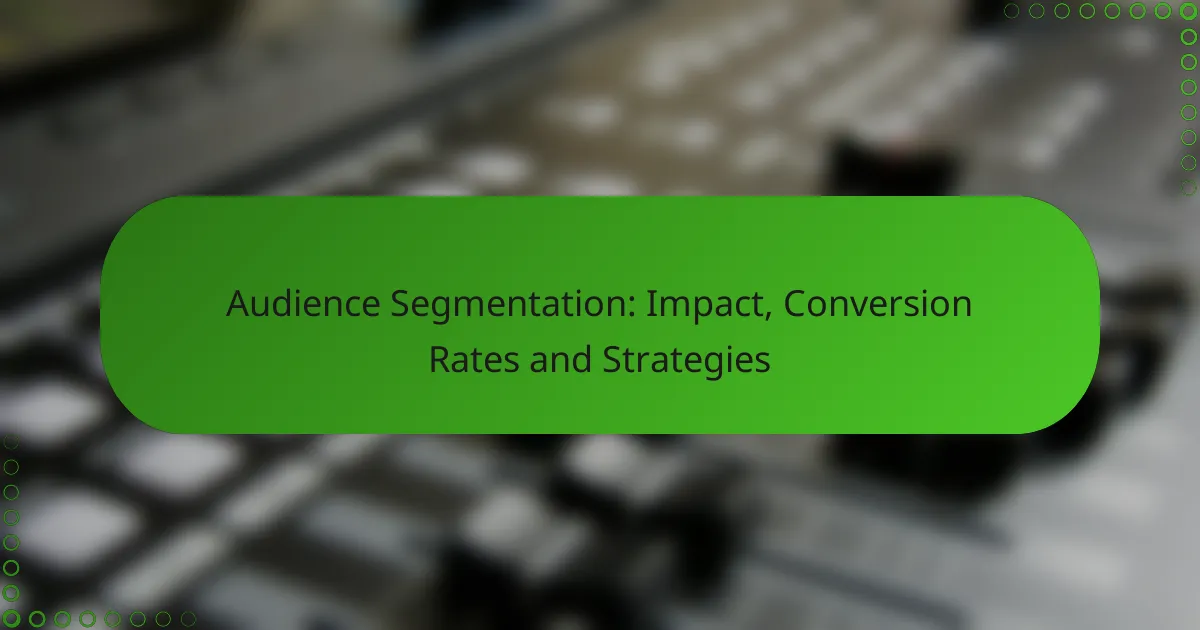Lookalike Audiences are a powerful tool in digital marketing, allowing businesses to target new potential customers who resemble their existing audience. By focusing on users with similar traits, this strategy enhances engagement and conversion rates, making advertising efforts more efficient. To maximize the effectiveness of Lookalike Audiences, it’s crucial to refine the source audience, experiment with audience sizes, and utilize engagement metrics for optimization.

How do Lookalike Audiences improve display advertising performance?
Lookalike Audiences enhance display advertising performance by targeting users who share similar traits with existing customers. This method increases the likelihood of engagement and conversion, making advertising efforts more effective.
Increased conversion rates
Using Lookalike Audiences often leads to higher conversion rates because the targeted users are more likely to be interested in the product or service. By focusing on individuals who resemble your best customers, you can create tailored messages that resonate more effectively.
For example, if your existing customers are primarily young professionals interested in fitness, targeting similar demographics can yield conversion rates that are significantly higher than generic campaigns. Many advertisers report improvements in conversion rates by 20-30% when utilizing Lookalike Audiences.
Enhanced targeting precision
Lookalike Audiences provide enhanced targeting precision by leveraging data from existing customer profiles to identify new potential customers. This data-driven approach allows advertisers to reach users who are not only likely to convert but also fit the desired customer profile.
Consider segmenting your audience based on behaviors, interests, or demographics. By refining your Lookalike Audience based on these factors, you can improve the relevance of your ads, leading to better engagement and lower bounce rates.
Lower customer acquisition costs
Implementing Lookalike Audiences can result in lower customer acquisition costs by optimizing ad spend. When ads are shown to users who are more likely to convert, the cost per acquisition (CPA) often decreases, allowing for a more efficient use of marketing budgets.
For instance, businesses may find that their CPA drops by 15-25% when targeting Lookalike Audiences compared to broader audiences. This not only maximizes the return on investment but also allows for reallocating funds to other marketing initiatives.

What is the reach of Lookalike Audiences in digital marketing?
Lookalike Audiences in digital marketing enable businesses to reach new potential customers who share similar characteristics with their existing audience. This approach enhances campaign reach by targeting individuals likely to engage based on their similarities to current customers.
Broader audience expansion
Utilizing Lookalike Audiences allows marketers to significantly broaden their audience base. By analyzing data from existing customers, platforms like Facebook and Google can identify and target users who exhibit comparable behaviors and interests. This can lead to increased engagement and conversion rates, as these new audiences are more likely to respond positively to marketing efforts.
When expanding your audience, consider starting with a Lookalike Audience that is 1% of your source audience size. This typically yields the highest similarity and engagement. As you gather more data, you can experiment with broader percentages to capture a wider audience, though this may dilute the targeting precision.
Access to untapped demographics
Lookalike Audiences provide access to demographics that may not have been previously targeted. This can include younger consumers, niche markets, or specific geographic regions that align with your brand’s offerings. By leveraging insights from your existing customer data, you can discover new segments that could be highly receptive to your products or services.
To effectively tap into these demographics, regularly update your source audience to reflect changes in your customer base. Monitor performance metrics closely to identify which Lookalike segments yield the best results, allowing for ongoing optimization of your marketing strategy.

How can you optimize Lookalike Audiences for better results?
To optimize Lookalike Audiences effectively, focus on enhancing the quality of your source audience, experimenting with audience sizes, and leveraging engagement metrics. These strategies can significantly improve your campaign performance and reach.
Refining source audience quality
The quality of your source audience directly impacts the effectiveness of your Lookalike Audiences. Start by ensuring your source audience consists of high-value customers who have engaged with your brand, such as recent purchasers or loyal subscribers.
Consider segmenting your source audience based on specific behaviors or demographics that align with your ideal customer profile. This targeted approach can lead to more relevant Lookalike Audiences, improving conversion rates and overall campaign success.
Testing different audience sizes
Experimenting with various audience sizes is crucial for finding the optimal reach and performance balance. Lookalike Audiences can typically be created in sizes ranging from 1% to 10% of the population, with smaller percentages often yielding higher-quality matches.
Start by testing a 1% audience for precise targeting, then gradually expand to 3% or 5% to assess performance. Monitor key metrics like engagement and conversion rates to determine which size delivers the best results for your specific goals.
Utilizing engagement metrics
Engagement metrics provide valuable insights into how your Lookalike Audiences are performing. Track metrics such as click-through rates, conversion rates, and cost per acquisition to evaluate the effectiveness of your campaigns.
Use these metrics to refine your targeting further. For instance, if a particular Lookalike Audience shows high engagement, consider creating additional segments based on similar characteristics to maximize your reach and impact.

What are the prerequisites for creating effective Lookalike Audiences?
To create effective Lookalike Audiences, you need a solid foundation of existing customer data and well-defined conversion goals. These elements ensure that the audience you target closely resembles your most valuable customers, maximizing your advertising effectiveness.
Existing customer data
Having robust existing customer data is crucial for developing Lookalike Audiences. This data can include email lists, website visitors, or customer interactions across various platforms. The more comprehensive and accurate your data, the better the algorithm can identify similar users.
Consider segmenting your customer data based on behaviors, demographics, or purchase history. For instance, targeting customers who have made a purchase in the last six months can yield more relevant Lookalike Audiences compared to a broader, less targeted approach.
Defined conversion goals
Clearly defined conversion goals are essential for optimizing your Lookalike Audiences. These goals guide the algorithm in understanding what actions you want users to take, such as completing a purchase or signing up for a newsletter. Without specific objectives, your audience may not align with your business needs.
Establish measurable goals, such as increasing sales by a certain percentage or boosting sign-ups within a specific timeframe. This clarity allows you to refine your audience targeting and improve overall campaign performance, ensuring that your advertising efforts are focused and effective.

Which platforms support Lookalike Audiences?
Lookalike Audiences are supported by several major advertising platforms, enabling businesses to target new customers who resemble their existing audience. These platforms include Facebook, Google, and LinkedIn, each offering unique features and methodologies for audience creation and optimization.
Facebook Ads
Facebook Ads utilizes Lookalike Audiences to help advertisers reach potential customers who share similar characteristics with their current audience. To create a Lookalike Audience on Facebook, you need a source audience, which can be based on customer lists, website visitors, or engagement data.
When setting up a Lookalike Audience, you can choose the audience size, ranging from 1% to 10% of the population in the selected country. A smaller percentage typically results in a more closely matched audience, while a larger percentage broadens your reach but may dilute the quality of the match.
Google Ads
In Google Ads, Lookalike Audiences are referred to as Similar Audiences, allowing advertisers to target users who exhibit behaviors similar to their existing customers. Google automatically generates these audiences based on your remarketing lists, which can include website visitors or app users.
To optimize your campaigns, consider using Similar Audiences alongside other targeting options like keywords and demographics. This combination can enhance your ad performance by reaching users who are more likely to convert based on their online behavior.
LinkedIn Ads
LinkedIn Ads supports Lookalike Audiences through its Matched Audiences feature, enabling advertisers to find new leads similar to their existing contacts. This is particularly useful for B2B marketers looking to expand their reach within specific industries or job functions.
To create a Lookalike Audience on LinkedIn, you can upload a list of your current customers or use LinkedIn’s insights to define your source audience. LinkedIn then identifies users with similar professional attributes, enhancing your targeting effectiveness in a professional context.

What are common mistakes in Lookalike Audience strategies?
Common mistakes in Lookalike Audience strategies include targeting too broad an audience, neglecting data quality, and failing to test and optimize campaigns. These pitfalls can lead to wasted ad spend and lower conversion rates.
Targeting too broadly
One frequent error is creating Lookalike Audiences that are too expansive, which dilutes the effectiveness of your targeting. Instead of reaching a highly relevant audience, you may end up attracting users who are less likely to convert. Aim for a Lookalike Audience size that balances reach and specificity, typically between 1% to 5% of your source audience.
To refine your targeting, consider segmenting your source audience based on specific behaviors or demographics. This can enhance the relevance of your Lookalike Audience, leading to better performance and higher engagement rates.
Neglecting data quality
Using low-quality or outdated data as the basis for your Lookalike Audience can significantly hinder performance. Ensure that your source audience consists of recent, engaged users who have interacted positively with your brand. This will help the algorithm identify similar, high-potential users more effectively.
Regularly audit your data sources and remove any inactive or irrelevant users. This practice not only improves the quality of your Lookalike Audience but also enhances the overall effectiveness of your advertising campaigns.
Failing to test and optimize
Many advertisers overlook the importance of testing different Lookalike Audiences and optimizing their campaigns based on performance. Failing to experiment with various audience sizes or characteristics can result in missed opportunities for better targeting. Regularly analyze campaign results and adjust your strategies accordingly.
Implement A/B testing to compare different Lookalike Audiences and identify which performs best. Use insights from these tests to refine your audience selection and improve your return on investment (ROI) over time.









